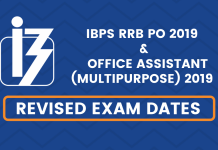NABARD, which stands for the National Bank for Agriculture & Rural Development, holds a pivotal role in ensuring the seamless operation and robust development of the Rural Banking system in India. The prospect of being a part of this influential institution is a dream for numerous aspirants, driven by the organization’s dedication to rural and agricultural growth. The anticipation among individuals escalates as they eagerly await the release of NABARD’s exam notification, signaling the beginning of a rigorous yet rewarding journey.
Embarking on a career at NABARD presents an opportunity to contribute significantly to the advancement of rural and agricultural sectors, crucial pillars of India’s economy. The organization’s far-reaching impact on the financial landscape amplifies its appeal as a workplace where one can make a tangible difference in India’s rural landscape.
The recently concluded NABARD Grade A 2023 recruitment drive marks a significant milestone, and aspirants are now gearing up for the upcoming NABARD Grade A 2024 recruitment cycle. This period signifies a renewed focus on preparation, dedication, and the pursuit of excellence as candidates strive to align their skills with the organization’s vision of fostering sustainable rural development and financial inclusion. Joining NABARD is not merely a career choice but an opportunity to be an integral part of positive change in the lives of millions residing in India’s rural areas.
In this blog, we will delve into the NABARD Grade A exam pattern and present sample questions for the Agricultural and Rural Development (ARD) section of the NABARD Grade A Phase 2 exam. Exploring the exam format and practicing with sample questions can enhance your preparation and boost your confidence for this crucial phase of the NABARD Grade A examination.

NABARD Grade A Phase 2 Exam Pattern
Before we move forward, it is crucial to clearly understand the sections included in the NABARD Grade A Phase 2 exam. Overlooking or being careless about even minor details can potentially result in significant setbacks or delay your journey to success. Let’s explore the particulars below to grasp the examination structure comprehensively.
NABARD has brought about a significant alteration in the pattern of the NABARD Grade A Phase 2 exam. This phase now comprises two distinct papers; each allocated its specific time duration. The General English paper for the NABARD Assistant Manager is designed in a descriptive format, spanning a total duration of 90 minutes. In contrast, the Economic and Social Issues (ESI) paper is both objective and descriptive. The objective segment has a timeframe of 30 minutes, and the descriptive section extends to 90 minutes, each contributing 50 marks to the overall assessment.
NABARD Grade A Paper 2 encompasses questions from Economic & Social Issues and Agriculture & Rural Development, with a particular emphasis on Rural India for the General post. This restructured format aims to comprehensively assess candidates on diverse aspects related to economics, social issues, and the intricacies of rural development. It is essential for aspirants to be well-versed in both objective and descriptive formats, ensuring a nuanced understanding of economic and social contexts, as well as agricultural and rural developmental nuances, to navigate through the NABARD Grade A Phase 2 exam successfully. Take a look at the NABARD Grade A exam pattern for Phase 2 in the table below.
| Paper | Subject | Type of Paper | No. of Questions | Marks | Duration | Remarks |
| Paper I | General English | Online Descriptive (Answers to be typed using a keyboard) | 3 | 100 | 90 Minutes | Descriptive Answers are to be typed using a keyboard |
| Paper II | Economic and Social Issues and Agriculture & Rural Development | Objective | 30 | 50 | 30 Minutes | |
| Descriptive Type (Answers to be typed using a keyboard either in English or Hindi (Remington and Inscript keyboards)) | 6 questions will be asked, of which candidates will be required to attempt 4 questions [2 of 15 marks each (with difficulty level) and 2 of 10 marks each] | 50 | 90 Minutes | Descriptive Answers are to be typed using a keyboard either in English or Hindi (Remington and Inscript keyboards) | ||
| Total | 100 (Paper II) | 2 Hours (Paper II) | ||||
NABARD Grade A Phase 2 Syllabus
In addition to comprehending the NABARD Grade A exam pattern, it is imperative to have a thorough understanding of the NABARD Grade A syllabus for the Phase 2 examination. Specifically, for the General stream, Paper 2 delves into topics related to Agriculture & Rural Development and Economic & Social Issues, explicitly focusing on Rural India. This nuanced knowledge of the syllabus is crucial for effectively navigating the varied dimensions of economic, social, and rural development issues during the NABARD Grade A Phase 2 examination. The NABARD Grade A syllabus for Phase 2 is given in detail in the table below.
| Subject | Topics |
| Agriculture | Agriculture: definition, meaning and its branches, Agronomy: definition, meaning and scope of agronomy, Classification of field crops, Factors affecting crop production, Agro Climatic Zones Cropping Systems: Definition and types of cropping systems, Problems of dry land Agriculture- Seed production, seed processing, seed villageMeteorology: weather parameters, crop-weather advisory, Precision Farming, Organic farming Soil and Water Conservation: Major soil types, soil fertility, fertilizers, soil erosion, soil conservation, watershed management Water Resource: Irrigation Management: types of irrigation, sources of irrigation, crop-water requirement, command area development, water conservation techniques, micro-irrigation, irrigation pumps, major, medium and minor irrigation Farm and Agri Engineering: Farm Machinery and Power, Sources of power on the farm- human, animal, mechanical, electrical, wind, solar and biomass, bio fuels, water harvesting structures, farm ponds, watershed management, Agro-Processing, Controlled and modified storage, perishable food storage, godowns, bins and grain silos. Plantation & Horticulture: Definition, meaning and its branches. Agronomic practices and production technology of various plantation and horticulture crops. Post-harvest management, value and supply chain management of Plantation and Horticulture crops. Animal Husbandry: Farm animals and their role in Indian economy, Animal husbandry methods in India, common terms pertaining to different species of livestock, Utility classification of breeds of cattle. Introduction to common feeds and fodders, their classification and utility. Introduction to poultry industry in India (past, present and future status), Common terms pertaining to poultry production and management. Concept of mixed farming and its relevance to socio-economic conditions of farmers in India. Complimentary and obligatory nature of livestock and poultry production with that of agricultural farming. Fisheries: Fisheries resources, management and exploitation – freshwater, brackish water and marine; Aquaculture- Inland and marine; biotechnology; post-harvest technology. Importance of fisheries in India. Common terms pertaining to fish production. Forestry: Basic concepts of Forest and Forestry. Principles of silviculture, forest mensuration, forest management and forest economics. Concepts of social forestry, agroforestry, joint forest management. Forest policy and legislation in India, India State of Forest Report 2017. Recent developments under the Ministry of Environment, Forest and Climate Change. Agriculture Extensions: Its importance and role, methods of evaluation of extension programmes, Role of Krishi Vigyan Kendra’s (KVK) in the dissemination of Agricultural technologies. Ecology and Climate Change: Ecology and its relevance to man, natural resources, their sustainable management and conservation. Causes of climate change, Green House Gases (GHG), major GHG emitting countries, climate analysis, distinguish between adaptation and mitigation, climate change impact on agriculture and rural livelihood, carbon credit, IPCC, UNFCCC, CoP meetings, funding mechanisms for climate change projects, initiatives by Govt of India, NAPCC, SAPCC, INDC. Present Scenario of Indian Agriculture and Allied activities; recent trends, major challenges in agriculture measures to enhance the viability of agriculture. Factors of Production in agriculture; Agricultural Finance and Marketing; Impact of Globalization on Indian Agriculture and issues of Food Security; Concept and Types of Farm Management. |
| Rural Development | Rural Area: Concept of Rural Area, Structure of the Indian Rural Economy Importance and role of the rural sector in India- Economic, Social and Demographic Characteristics of the Indian rural economy, causes of Rural Backwardness Rural population in India: Occupational structure, Farmers, Agricultural Labourers, Artisans, Handicrafts, Traders, Forest dwellers/tribes and others in rural India- Trends of change in rural population and rural workforce; problems and conditions of rural labour; Issues and challenges in Handlooms Panchayati Raj Institutions: Functions and Working. MGNREGA, NRLM – Aajeevika, Rural Drinking Water Programmes, Swachh Bharat, Rural Housing, PURA, and other rural development programmes. |
NABARD Grade A Phase 2 Sample Question & Answer
Now that you’ve familiarized yourself with the NABARD Grade A Phase 2 exam pattern and syllabus let’s explore a sample question and its answer. This hands-on experience will help you apply your knowledge, bridging the gap between theory and practical application, ensuring you’re well-prepared for the challenges of the NABARD Grade A Phase 2 examination.
Question: What is the Minimum Support Price (MSP), what agencies are involved, and what are the methods of calculating MSP? How will MSP help the farmers to ensure remunerative returns for their produce?
Answer: The minimum support prices are a guarantee price for farmers produce from the Government to protect farmers from sharp falls in farm prices, and it is fixed before the sowing of the crop, prior fixation of MSP helps the farmer in making selections regarding the crop, MSP protects the producer – farmers – against excessive fall in price during bumper production years and to support the farmers from distress sales and to procure food grains for public distribution. The government announces minimum support prices (MSPs) for twenty-two mandated crops and Fair and Remunerative Price (FRP) for sugarcane. Kharif season- fourteen crops, Rabi season- six crops, and Commercial crops – two Crops.
For announcing the MSP government considers the various points, i.e., demand and supply, cost of production, price trends in the market, both domestic and international, inter-crop price parity, terms of trade between agriculture and non-agriculture, a minimum of 50 percent as the margin over cost of production and likely implications of MSP on consumers of that product.
Commission for Agricultural Cost and Pricing (CACP) is mandated to recommend minimum support prices (MSPs) to incentivize cultivators to adopt modern technology and raise productivity and overall grain production in line with the emerging demand patterns in the country. The central government on the recommendation of CACP, state government, and other stakeholders announces the MSP.
For the Calculation of MSP following methods are used
- A2- MSP is set 50% higher than the amount a farmer spends on farming, including spending on seeds, fertilizers, pesticides, and labor.
- A2+FL- MSP is set 50% higher than the amount that derives from adding the amount farmers spend on farming, including spending on seeds, fertilizers, pesticides, and labor and the value of labor provided by the family members for agriculture.
- C2- Makes the calculation by including a wider range of inputs. This includes besides factors used to calculate A2, the economic value of the efforts of family members working on the farm and the value of other spending including rent and other assets.
At present, CACP considers both A2+FL and C2 costs while recommending MSP. CACP reckons only A2+FL cost for return. However, C2 costs are used by CACP primarily as benchmark reference costs (opportunity costs) to see if the MSPs recommended by them at least cover these costs in some of the major producing States.
MSP is an assurance of a remunerative and stable price environment and is considered very important for increasing agricultural production and productivity since the marketplace for agricultural produce tends to be inherently unstable, which often inflicts undue losses on the growers, even when they adopt the best available technology package and produce efficiently.
- It enables farmers to make choices for the selection of crops, using new technologies and help in taking calculated risks.
- MSP has set a benchmark for the farmers and traders to negotiate after the harvest of crop
- MSP helps farmers to set up contracts under contract farming so that they can get better prices over and above MSP
- MSP acts as a support to the farmers that also ensures the continuance of farming and helps in adopting new technologies, increasing investment in agriculture.
- Focus on the production of nutrient-rich nutrient-cereals also to realign the MSPs in favour of oilseeds, pulses, and coarse cereals to encourage farmers to shift to these crops.
Practice Questions for You
- Which cropping system is the outcome of the green revolution and how did it help in making India food self-sufficient? What are the challenges India faces as the negative outcome of this cropping system?
- Why is the rural population most prone to migration? What can be done to address this issue as far as rural infrastructure is concerned?
- What are the government initiatives regarding the upliftment of rural women for employment generation and rural women empowerment?
- What are prevalent cropping patterns in India in the various climatic conditions? What is cropping intensity, and how does it differ from rotational intensity?
Prepare with ixamBee!
ixamBee offers many resources to support your preparation for the NABARD Grade A Mains examination.
NABARD Grade A Free Mock Tests
We trust that you’ve already engaged in mock tests for your NABARD Grade A Prelims, and now, for your convenience, we’ve curated specialized NABARD Grade A mock tests exclusively designed for Phase 2 of the NABARD Grade A exam. These tailored practice sessions are crafted to help you navigate the unique challenges posed by the Phase 2 examination, ensuring a comprehensive and effective preparation experience.
NABARD Grade A Phase 2 Previous Year Question Papers
In your quest for exam preparedness, exploring sample questions is beneficial, but it’s equally prudent to delve into previously tested questions. Hence, examining NABARD Grade A previous year papers is a wise approach. This not only familiarizes you with the exam pattern but also provides insights into the types of questions that have historically been presented, offering a valuable perspective to refine your strategy and enhance your readiness for the upcoming NABARD Grade A examination.
NABARD Grade A Mains Online Course
ixamBee introduces an exclusive NABARD Grade A Phase 2 Online Course, bringing together all exam-related materials onto a unified platform. This meticulously designed course aims to furnish candidates with comprehensive guidance, offering in-depth insights and strategic approaches essential for navigating the challenges posed in the NABARD Grade A Mains examination. By consolidating resources and providing expert-curated content, this course enhances candidates’ preparedness, ensuring they are well-equipped to tackle the complexities of the Phase 2 examination and excel in their pursuit of success in the NABARD Grade A recruitment process.
To help you prepare 50% faster for competitive exams, ixamBee provides free Mock Test Series and all the Current Affairs in English and Current Affairs in Hindi in the BeePedia capsules for GA Preparation. You can also get the latest updates for Bank PO, Bank Clerk, SSC, RBI Grade B, NABARD and Other Government Jobs.
Also Read
How To Prepare for the NABARD Grade A Mains Exam?
Preparation Strategy for NABARD GRADE A Prelims Exam
What To Do While Preparing for NABARD Grade A Phase 2 Exam
Target NABARD Grade A 2024: A New Year Resolution
Best Books For NABARD Grade A & B Exam Preparation














